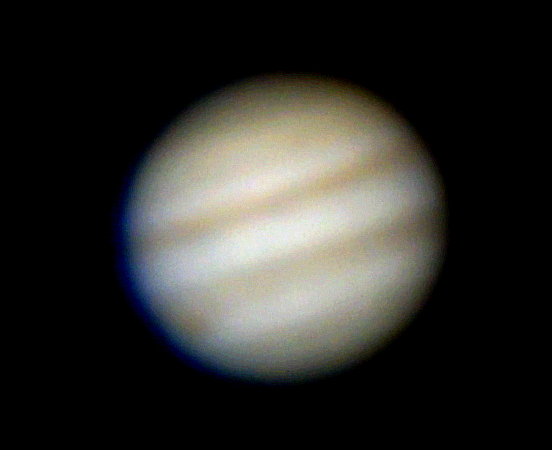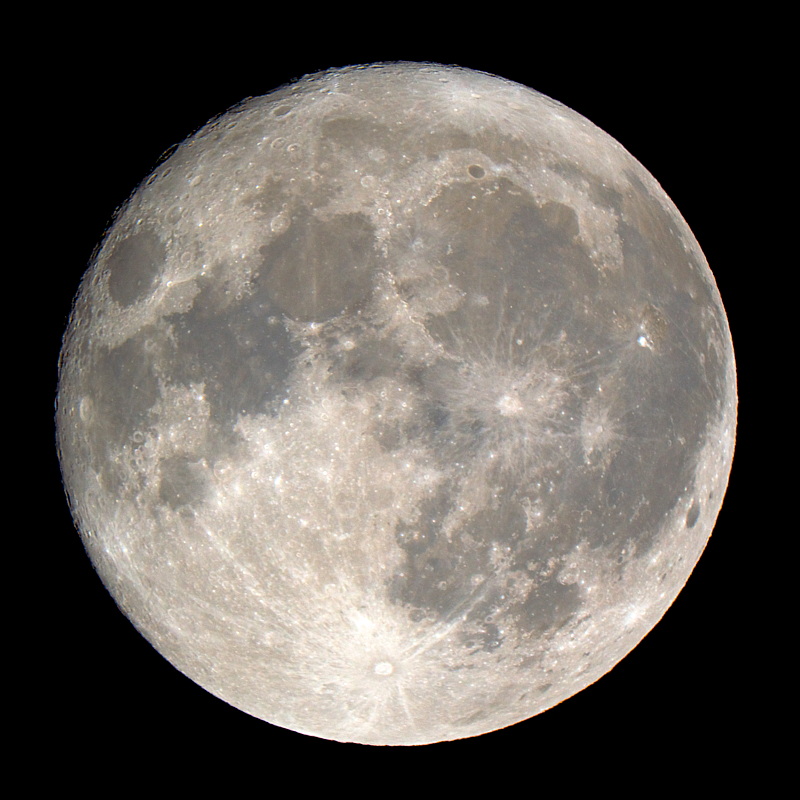
More Jupiter Video Tests, Day Past Full Moon
Posted: 17 January 2014
|
Opened: Thursday, 16 January 2014, 1815 MST Temperature: 64°F |
Session: 647 Conditions: Clear, calm |
First began viewing Jupiter, low in the east, at 1823 MST using 83X. The four Galilean Moons were visible. At 1830 MST, switched to 222X to monitor seeing conditions as Jupiter rose higher in the sky. I then synced the observatory clock to WWV. The eastern sky was beginning to brighten due to the rising day past full moon.
At 1837 MST, with some difficulty I saw the Great Red Spot at the central meridian. It hadn't been visible before this due to poor seeing. Seeing was slightly better now, and by 1851 MST, the Great Red Spot was easy to see using 222X.
The moon began to rise over the hill to the east at 1910 MST, and at 1915 MST, I took a quick look at it, 222X. A slight terminator was visible less than 24 hours after being Full.
Then went back to Jupiter observing. Seeing was a little worse now. I continued to monitor seeing using 222X. By 1940 MST, seeing was improving somewhat. I could get 1 to 2 seconds of steady viewing of Jupiter using 222X. During the brief steady seeing times, some nice details were visible in the South Equatorial Belt trailing the Great Red Spot.
I set up for D7000 DSLR HD video recording tests using eyepiece projection 444X on the 8" LX200-ACF. I first did a focus test on the star Betelgeuse using the Bahtinov Mask. At 1954 MST, I began doing a series of HD video recordings using exposure settings of 1/30sec, 1/40sec, 1/50sec, and 1/60sec at ISO 4000, ISO 5000, and ISO 6400. Unlike on past nights when I did 30 second long recordings, due to seeing only being steady for 1-2 seconds, this night I did recordings for only 15 seconds. During post-processing I trimmed the video to about 1 second length during the time of steady seeing. The best exposure was 1/30sec, ISO 5000. This is a stack of 25 frames:

The Great Red Spot is visible at the left below the South Equatorial Belt. Not a great image but stacking less frames worked out better than stacking more frames. I will do more tests on the next session using a lower magnification.
I resumed Jupiter observing, 222X, at 2005 MST. Seeing was fairly good now. The Great Red Spot was rotating out of view.
Slewed to the moon at 2017 MST. It was still low in the east, but there was some nice views along the terminator using 222X. Added the focal reducer and mounted the D7000 DSLR at the 8" prime focus + visual back. Took this photo at 2024 MST, 1/640sec, ISO 100:

Removed the camera and focal reducer, and at 2029 MST, viewed the moon using the 2" 24mm UWA eyepiece (83X). Very bright, with nice details visible. BUT I really do need to get a 2" moon filter since I prefer using the 2" 24mm UWA eyepiece over the 1.25" 26mm eyepiece.
|
Closed: Thursday, 16 January 2014, 2047 MST Temperature: 52°F |
|
Comments are welcome using Email. Thanks.
Cassiopeia Observatory Home Page